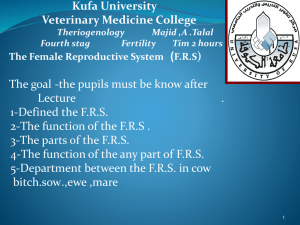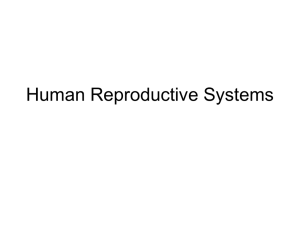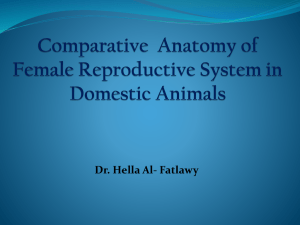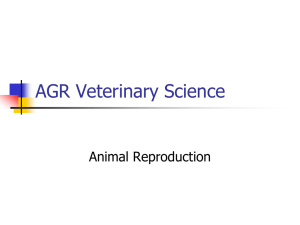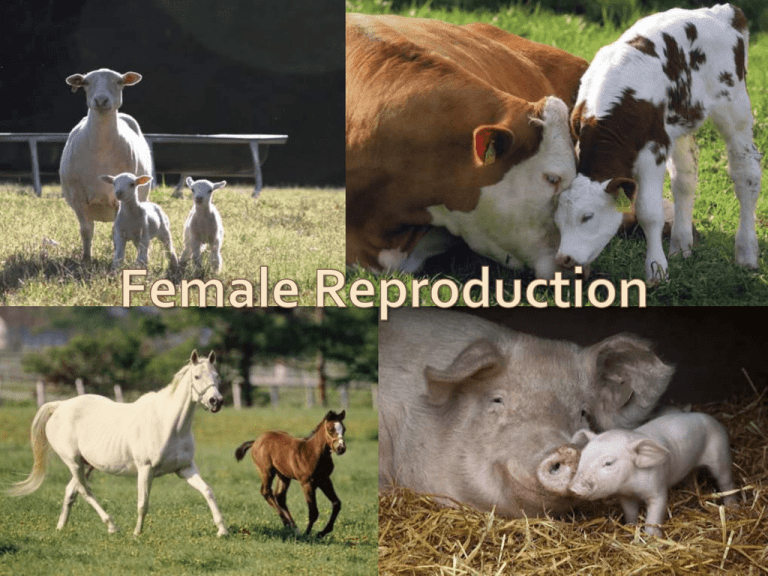
As you go through the slides, READ and RE-READ
information to help your understanding.
Take notes on IMPORTANT information, functions,
and items that meet class objectives. (FYI slides are
just that FYI)
When you see a STOP slide, stop and complete the
check in.
When you see an unfamiliar word, ASK or look it up.
ASK if you have questions.
Function of the female reproduction system:
Produce an fertile egg
Produce hormones
Reset the ovulation cycle
Transport the egg and sperm to the site of
fertilization
House, protect, and grow a fetus and placenta
Birthing of the fetus
Estrous vs. Estrus
Estrous: the entire cycle that occur between when
the animal goes into heat and ovulation.
Estrus: the period of standing heat. The female is
sexually receptive to the male.
Ovulation: Occurs when the egg is released
from the follicle to be fertilized.
Oocyte = egg
Vulva
Vagina
Cervix
Uterus
Oviducts &
Infundibulum
Ovaries
Corpus Luteum
Follicles & Eggs
Look at this picture & predict structure function
WHAT:
“Entranceway” of the female reproductive tract
Only part visible from the outside
WHY:
Swells and becomes reddish-pink during estrus
▪
Response due to estrogen
Allows for penetration and insertion to
reproductive tract
WHAT : flattened tube; passage between
the cervix and the vulva
WHY :
1. Site of semen deposition during natural
insemination
2. Used as passageway for instruments
during AI
3. Produces mucus (lubricant)
- flushes out irritants and
infectious agents
-common site of infection
Vagina Species
Differences:
▪ Only the bull and ram will
deposit sperm here
▪ Boar and Stallion deposit
sperm in the cervix at the
opening of the uterus
Vulva:
▪ Left and Right Labia: 1st
defense against bacteria
entering the reproductive
tract
Anus
Left Labia
Right Labia
WHAT: the muscular “valve” or “control gate”
between the uterus and the vagina
Made of muscular folds that slow down invading
materials
These folds have ‘dead ends’ that trap foreign
substances
WHY: Completely closed except during estrus and
parturition (birthing) to prevent foreign
substances/infection.
Opens during estrus/parturition to allow for young/sperm
During pregnancy, a hard mucus plug “glues” it
shut
Forms a VERY tight barrier between itself and the uterus
Species Differences in the Shape of the Cervix:
Cow, Ewe, Nanny: Annular Rings
Sow: Corkscrew Shape
Mare: Longitudinal Folds
Species Differences between Males:
Stallion and Boar will deposit sperm here at the opening of
the cervix
Ram and Bull deposit sperm in the vagina
Annular
Rings
Annular
rings
UTERUS WHAT: Womb
Muscular, capable of “enormous expansion”
Has to support up to 80 kg / 177 lbs of weight
UTERUS WHY: Where fetus grows
Uterine Horns WHAT:
The extensions on either
side of the uterus
▪ Curl like ram horns
Uterine Horns WHY:
Connect to Oviducts
Simplex
▪ Uterine body has NO uterine horns
▪ Example: primates and humans
Duplex
▪ Two cervices that form into two uterine bodies and two uterine horns
▪ Example: marsupials and rabbits
Bicornuate
▪ Two uterine horns
▪ Depending on the species will either have poorly developed uterine
horns or highly developed horns
▪ Development depends on litter size
▪ Larger the litters the longer and more developed the uterine horns
▪ Smaller the litters the shorter and less developed the uterine horns
▪ Example: ALL Livestock
▪ Sow, Bitch, Queen: Highly Developed Uterine Horns
▪ Cow, Ewe, Mare: Poorly Developed Uterine horns
Uterine
Body
Cervix
Oviduct
Uterine Horn
WHAT: tubes that carry eggs from ovaries to uterus
Kept shut tight except during ovulation and insemination
WHY: Where fertilization occurs
Egg moved from the ovaries down the oviduct by cilia
(microscopic hairs)
Motile sperm meet the egg in the upper part of the oviduct
Newly formed zygote stays in the oviduct 3-4 days
This time is needed for the uterus to prepare itself
WHAT: Latin for “funnel”
The end projection of the oviducts that surrounds,
but does not connect to, the ovaries
WHY: “Funnels” eggs from ovaries into
oviduct.
WHAT:
Small walnut-shaped ovals 4-6 cm / 2-3 inches in
length
Contain thousands of ova (plural of ovum, or egg
cell)
▪ These were created before the birth of the cow
▪ Has a finite supply, as do human females
WHY:
Produce a mature ovum (oocyte) (egg) every 21
days
Produce/secrete hormones that:
▪
▪
▪
▪
▪
Control growth of egg
Change cow’s behavior (gets her “in the mood”)
Prepare reproductive tract for pregnancy
Start parturition process (birthing)
Prepare mammary glands for lactation
Follicles – start as cavities (holes) on the
ovary
An egg moves to this cavity.
It is surrounded by support cells and nutritive
substances
All these things together are the follicle
The cells that remain in the follicle after the
egg is ovulated (expelled into the oviduct)
become the corpus luteum (CL)
Corpus luteum translated = yellow body
Produces progesterone, a hormone which
sustains the pregnancy (allows pregnancy to
“progress”)
Occurs regardless of fertilization
Female gamete (reproductive cell)
Haploid - half the number of normal
chromosomes
Present prior to birth, but maturation occurs
at puberty
Multiple eggs develop during a cycle, but only
one matures
Female Reproduction video
What is a hormone?
Definition: a chemical messenger that travels to
specific organs and prompts a specific response from
the organ
Characteristics of Hormones:
▪ Low amounts are secreted
Important Hormones: (get down each & function)
▪
▪
▪
▪
Estrogen
Progesterone
Follicle Stimulating Hormone (FSH)
Luteinizing Hormone (LH)
Estrogen - Produced by: Ovary (Follicle)
▪ Regulate reproductive cycling
▪ Behavioral displays during estrus
Progesterone - Produced By: Ovary (Corpus Luteum)
▪ Essential for the maintenance of pregnancy
Follicular Stimulating Hormone (FSH) - Produced by:
Anterior Pituitary in the brain
▪ Causes follicular growth in the ovary
Luteinizing Hormone (LH) - Produced by: Anterior Pituitary
in the brain
▪ Responsible for causing ovulation
▪ Stimulating the Corpus Luteum(Follicle stage) to secrete
progesterone
Estrous: the entire cycle that occur between when
the animal goes into heat and ovulation.
Estrus: the period of standing heat. The female is
sexually receptive to the male.
Luteal Phase:
Diestrus:
▪ Peak Progesterone Production
Proestrus
▪ Formation of follicles
Follicular Phase:
Estrus
▪ Sexual receptivity
▪ Peak Estrogen secretion
Metestrus
▪ Corpus Luteum Formation
P4 = Progesterone
E2 = Estrogen
Vulva: swollen due to estrogen, covered in mucus
Vagina: excess mucus production
Cervix: dilates to allow acceptance of semen (otherwise
locked shut with hardened mucus to prevent infection)
Oviducts: open to allow ovulation, fertilization
Ovaries: ovulation – release of the follicle (egg and some
supporting cells) from the ovary
number of young that a female can produce at one time is
determined by how many eggs are released during ovulation
ovulation usually occurs at the end of a heat/estrus
MAKE SURE YOU KNOW THESE !
Closed Cervix – cervix does not open to allow fert.
Retained Placenta – afterbirth stays in cow
Damaged Oviduct (due to excess palpation)
Freemartins – heifer exposed to male hormones
Cystic ovaries – growth/swelling of ovaries
Infection – varies
Anovulation – lack of ovulation
Metritis – inflammation of lining of the uterus
F
A
E
B
C
D
Female Reproductive System in Poultry
The functional parts of the
female poultry reproductive
tract includes one ovary, an
oviduct, and the cloaca.
Female Poultry Reproductive Tract
Mature female poultry have only one
functional ovary; the right ovary and
oviduct degenerate and cease
functioning before the bird reaches
sexual maturity.
The ovary appears as a cluster of
tiny, gray balls that are the oocytes.
At maturity, the ovary contains up to
4,000 tiny oocytes from which ovum
may develop over time.
An ovum develops by collecting lipid
particles from the blood to form the
yolk.
The yolk contains fat for energy and
some protein and other nutrients
needed by the developing embryo, as
well as, a small white dot called the
blastodisc that contains the genetic
information supplied by the female.
When mature, the yolk is released by
the follicle and engulfed by the
infundibulum.
The oviduct is about 25 inches long and
consists of five parts: the
infundibulum, the magnum, the
isthmus, the uterus, and the vagina.
Infundibulum – funnel-like part of the
oviduct that receives the yolk and is the site
of fertilization.
Magnum – second part of the oviduct that
secretes the thick white or albumen.
Isthmus – third part of the oviduct that
adds the two shell membranes.
Uterus – the fourth part of the
oviduct that secretes the thin
white, the shell, and the shell
pigment.
Vagina – the last part of the oviduct
that holds the egg until it is laid.
From the oviduct, the egg
passes to the cloaca and then
out of the body through the
vent at the time of laying.
In addition to producing ova, the ovary
produces the female sex hormone,
estrogen, and the hormone androgen.
The androgen hormone stimulates
comb growth and works with other
hormones in egg production.
In poultry, the functions of estrogen include:
• stimulating the growth of the oviduct,
• increasing the size of the cloaca during
egg laying,
• modifying feather shape and
pigmentation of the female, and
• increasing the level of fat, phosphorus,
and calcium in the blood.
Length of the estrus cycle is species specific
Cattle 18 – 24 days
Swine 18 – 24 days
Sheep 14 – 20 days
Horses 16 – 30 days
Goats 15 – 24 days
Dogs 3 ½ - 13 months
Cats 14 – 21 days
Estrus by species
Cattle – 14 hrs
Swine – 2-3 days
Sheep – 30-35 hrs
Horses – 6 days
Goats – 42 hrs
Dogs – 6-12 days
Cats – 6-7 days
Stands to be mounted
Frequent urination
General nervousness
BE SURE YOU KNOW THIS
Cattle – 283
Swine – 113
Sheep – 150
Horses – 336
Goats – 151
CONVERT THESE TO MONTHS – BE
SURE YOU KNOW THEM!
Initiated by hormones secreted by the offspring.
Oxytocin from the posterior pituitary gland travels to
the muscles of the uterus to cause contractions.
Pressure against the cervix will neurologically message
the pituitary.
Fluids from the fetal membranes will lubricate the
cervix and vagina for ease of offspring passage.
The final phase of parturition is the expulsion of the
fetal membranes or afterbirth.
Hormone Reference
Female Organ Reference
Waterford PowerPoint Template




